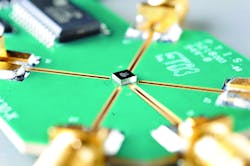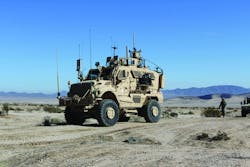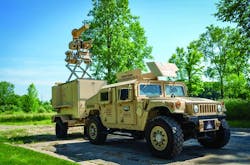Military re-learns the importance of electronic warfare (EW)
The need to dominate the electromagnetic spectrum never has been higher for the U.S. military since the end of the Cold War. By using electronic warfare (EW), branches under the Department of Defense (DOD) umbrella can go on the attack and protect American warfighters and military resources.
This fall, the DOD unveiled its Electromagnetic Spectrum Superiority Strategy, which outlines how the U.S. military aims to dominate the electromagnetic spectrum when it is challenged by peer and near-peer adversaries.
“The Department is transitioning from the traditional consideration of EW as separable from spectrum management to a unified treatment of these activities as Electromagnetic Spectrum Operations (EMSO),” Secretary of Defense Mark Esper wrote in the foreword to the publication released in October 2020. “Consequently, this 2020 Department of Defense EMS Superiority Strategy builds on essential objectives from the 2013 DOD EMS Strategy and the 2017 DOD EW Strategy, and takes the Department another critical step forward in implementing the 2018 National Defense Strategy. This Strategy seeks to align EMS resources, capabilities, and activities across the DOD to support our core national security objectives while remaining mindful of the importance of U.S. economic prosperity. Additionally, this Strategy lays the foundation for a robust EMS enterprise, prepares EMS professionals to leverage new technologies, and focuses on strengthening alliances to achieve the Department’s vision of Freedom of Action in the Electromagnetic Spectrum.”
“U.S. military operations are rarely conducted unilaterally and are increasingly reliant on contributions from our allies and partners,” DOD experts write in the strategy. “DOD must ensure EMS enterprise development efforts are interoperable and aligned with our allies and partners and should remove barriers limiting collaboration. This requires interoperable data sources and architectures. The Department will help develop military-to-military agreements, host nation agreements, agreements with the North Atlantic Treaty Organization (NATO), and other allies and partners focused on enabling coalitions the use of their full portfolio of EMS capabilities.”
The report continues, “This requires the means (software, data standards, transport channels, etc.) to move and process data at machine speeds with allies and partners. DOD must encourage our allies and partners to adopt, build, or enhance EMS capabilities that will increase our combined coalition EMS capability and capacity with particular focus on near-peer threats. This cooperation includes the need to expand opportunities for coalition EMS testing, training, and education in the United States and abroad.”
Jonathan Leitner, the radio frequency (RF) product marketing engineer for Menlo Microsystems Inc. in Irvine Calif., notes that “Battlespace dominance requires the upper hand in tactical and strategic troop and asset capabilities, and superiority with C6ISR — command, control, communications, computers, cyber-defense and combat systems and intelligence, surveillance, and reconnaissance. All of these are interconnected in a fabric that is reliant on the electromagnetic spectrum, particularly radio frequencies from HF to millimeter-wave. The U.S. will need to maintain a level of supremacy in the core RF technologies, from the component to the systems level. This will require that domestic companies stay far ahead of adversaries in core research in semiconductors, materials sciences, architectures, software tools, and manufacturing.”
Menlo Micro’s Leitner notes that the company is making a concerted effort into the aerospace and military sector, including EW, RF front ends, radar, and tactical and military communications systems.
“Menlo Micro has introduced the MM5130, which is currently in production and operates from DC to 26 GHz,” Leitner says. “We’ve coined the term, ‘Ideal Switch’ as the MM5130 combines the attributes and advantages of mechanical relays with those of solid-state switch technology. We’ve incorporated the MM5130 Ideal Switch into a new high power MM6000 series reconfigurable filter product. The key advantage of a filter designed using the Ideal Switch are the ultra-low losses of the RF paths, fast switching speeds, and very high-power handling and linearity levels. What is also unique are the extreme levels of ruggedness that the switch and therefore filter can handle. The core MEMS technology of the switch’s contact and beam structure have ultra-low mass and thus can withstand very high levels of shock and vibration. Much higher levels than what is capable with traditional RF relays and switches.”
Unmanned EW
Electronic warfare capabilities increasingly are being added to unmanned platforms, whether they are in the sky, on the ground, and even underwater.
“Unmanned EW platforms can take humans out of direct conflict, which saves lives, but will limit the ability to discern nuances that only well-trained personnel can detect,” says Menlo Micro’s Leitner. “This is why EW platforms will still be required for command, control, and communications. Unmanned systems will grow more important as a complementary platform but not as a replacement to piloted ones.”
Jeff Bateman, line manager of field-programmable gate array (FPGA) products at Curtiss-Wright Defense Solutions in Santa Clarita, Calif., says that using unmanned vehicles for EW will enable the swarming of large numbers of drones.
“For example, increased sensor bandwidth could be accommodated by upgrading the RF and data converter boards, while upgrading to newer DSP or GPGPU boards satisfies increased processing requirements,” Bateman says. DSP stands for digital signal processing, while GPGPU stands for general-purpose graphics processing unit.
Electronic warfare platforms also are following military and aerospace industry trends in embracing open-systems standards.
“The use of open standards eases integration between different pieces of the EW system technology chain,” Bateman continues. “So, you can have a tuner outputting data in a standardized form, such as VITA 49 (VITA Radio Transport) to an FPGA-based device or SBC. The receiving device can then ingest that data in a standardized way then process that data. So, integration of components from different parts of Curtiss-Wright or even different companies is eased by that standardization.”
Bateman says that Sensor Open Systems Architecture (SOSA) standards help build upon existing VITA VPX standards.
“SOSA also eases the integration of different types of processing in an EW system, so that you can leverage a wide variety of processing types, for example, FPGA, SBC or GPU processing,” says Bateman. “Different types of hardware can be easily and more readily applied in the same physical environment thanks to standardized and defined pin-outs, etc. That means, too, that you can more easily change the system configuration in the future if needed, if, for example, a new higher-performance FPGA or DSP becomes available. Upgrades are simplified because of standardization.
“EW by its very nature is a protean challenge that is continually evolving as adversaries develop new techniques and technologies. To keep up with these ever-changing requirements you need a smooth path for upgradeability, which is why open standards are so attractive,” concludes Bateman.
Army aerial EW
U.S. Army officials announced last year that they would move forward with an EW pod made by Lockheed Martin to be put on the MQ-1C Gray Eagle unmanned aerial system (UAS). The pod, dubbed “Air Large,” provides the Army with capabilities to jam equipment as well as provide electronics support and sense the EMS.
“Our internal research & development programs have resulted in first-of-its-kind converged technologies that are at the forefront of realizing our customers’ urgent need and vision for combined cyber and EW capability and dominance,” says Deon Viergutz, vice president of Lockheed Martin’s Spectrum Convergence division.
Last year, the Army announced a plan to defeat swarms of EW-enabled air-launched drones with its Air Launched Effects (ALE) family of systems. The Army says that its air-launched multipurpose UAS will be able to act as scouts or decoys, go on the offensive with electronic attacks, and even act as a “suicide drone.” The military branch says that the ALEs will be integrated into existing and future unmanned (and manned) platforms.
“ALE is a crucial piece of the Future Armed Reconnaissance Aircraft Ecosystem advanced team concept synergistically enhancing survivability, threat identification, targeting, and lethality of Army aviation brigades and ground force commanders’ assets,” Army officials say. “The ALE FoS extends tactical and operational reach and lethality of manned assets, allowing them to remain outside of the range of enemy sensors and weapon systems while delivering kinetic and non-kinetic, lethal and non-lethal mission effects against multiple threats, as well as, providing battle damage assessment data. They will provide scalable effects to detect, locate, disrupt, decoy, and/or deliver lethal effects against threats.”
Terrestrial counter-UAS
On the ground, U.S. forces and allies must counter UAS armed with EW capabilities alongside traditional munitions.
Last summer, Liteye Systems Inc. in Centennial, Colo., announced its Trailer Anti-UAS Defense System (T-AUDS), with an On-the-Move and Fixed-Site Counter Unmanned Aircraft Systems (C-UAS) solution. T-AUDS, is a Multi-Domain Awareness and Protection package, capable of detecting and defeating RF controlled and silent flight drones while mobile, then transiting from on-the-move to static in less than two minutes, with full capabilities being brought to bear in defense of a location.
Late last year, the U.S. Air Force announced a contract to Black Sage of Boise, Idaho to take down enemy drones with its Tactical High Power Microwave Operational Responder (THOR).
The Air Force Research Laboratory (AFRL) aims to use the CUAS radar system to provide precise targeting data to down enemy drones.
To provide the precise targeting data required by the THOR system, Black Sage utilized its proprietary DefenseOS software to receive and process data from the CUAS radars and export the data to the US military’s Forward Area Air Defense Command and Control (FAAD C2). During a successful evaluation, the integrated CUAS radar system, FAAD C2 and THOR weapon targeted and defeated drones.
THOR is a counter-swarm electromagnetic weapon supervised by AFRL for defense of air bases. The system provides non-kinetic defeat of multiple targets. It operates from a wall plug and uses energy to disable drones. The system uses High Power Microwaves (HPM) to cause a counter electronic effect. Targets are identified, the silent weapon discharges in a nanosecond, and the impact is instantaneous.
Naval EW
Last year Dino Mensa, a senior scientist-technology manager for EW technologies at Naval Air Systems Command at Patuxent River Naval Air Station, Md., said the Navy also is committed to electromagnetic spectrum dominance and airborne EW provides “reach and agility and the ability to go out and come back without putting boots on the ground.”
The Navy aims to equip all its combat aircraft with at least some level of EW capability, going beyond the well-equipped EW-ready EA-18G Growler.
He continues, “In the last three or four years, while the technology has kept advancing, we’ve had a cultural shift to focus on what technology we can speed to the fleet, to be ready to fight tonight. For the past 10-to-20 years, we were looking at what we could do 10 years down the road. Now we are accepting more risk, looking at what we can do today. We really need to respond fast. We still maintain a five-year plan and our program office road maps and science and technology advisors whose job is to think ahead. Develop tonight and deliver tomorrow really focuses on what we can do and I don’t see those [and long-range efforts] as competing priorities. But the need to keep pace with our adversaries has been heightened in the last few years.
“In that, I look at the industry more as a partner than a recipient of requirements. It’s much more productive to have a collaborative exploration of the options and look at requirements as the spirit rather than as a checklist,” Mensa concludes.
Collaboration is key
DOD officials also cite collaboration as a key part of its fourth goal listed in the EMS Superiority Strategy: securing enduring partnerships for an EMS advantage.
“Strong international alliances and partnerships are foundational to the Department’s ability to execute its complex global missions and conduct effective operations in the EMS as referenced in the NDS,” says the DOD in its strategy.
“The Department must rely on strong international alliances and partnerships to ensure EMS access policies support the U.S. military in conducting its full range of global operations. Successful engagement in the International Telecommunication Union (ITU) treaty processes, including the World Radio-communication Conference (WRC), will help to maximize DOD EMS access where and when needed to meet wartime and peacetime national security objectives. Of note, this successful international engagement begins with effective Department participation in domestic processes.”
“DOD must ensure EMS enterprise development efforts are interoperable and aligned with our allies and partners and should remove barriers limiting collaboration,” says the DOD. “This requires interoperable data sources and architectures. The Department will help develop military-to-military agreements, host nation agreements, agreements with the North Atlantic Treaty Organization (NATO), and other allies and partners focused on enabling coalitions the use of their full portfolio of EMS capabilities. This requires the means (software, data standards, transport channels, etc.) to move and process data at machine speeds with allies and partners. DOD must encourage our allies and partners to adopt, build, or enhance EMS capabilities that will increase our combined coalition EMS capability and capacity with particular focus on near-peer threats. This cooperation includes the need to expand opportunities for coalition EMS testing, training, and education in the United States and abroad.”
On the ground
EW systems go beyond shipboard, UAS, and airborne platforms. Last month, the U.S. Army announced that it would be ensure every brigade combat team will have an EW platoon and a separate signals intelligence (SIGINT) network support team.
This gels with the preface penned by Maj. Gen. Robert M. Dyes Jr. for the U.S. Army Concept for Cyberspace and Electronic Warfare Operations 2025-2040.
“Defeating future enemies that possess advanced capabilities calls for land forces operating as part of integrated joint teams that conduct simultaneous and sequential operations across multiple domains,” Dyes wrote in 2018. “In multi-domain battle, future Army forces will fight and win across all contested spaces to create windows of advantage across multiple domains that enable Joint Force freedom of action to seize, retain and exploit the initiative.
“The Army will operate in and through cyberspace and the electromagnetic spectrum and will fully integrate cyberspace, EW, and electromagnetic spectrum operations as part of joint combined arms operations to meet future operational environment challenges,” Dyes continued. “These operations provide commanders the ability to conduct simultaneous, linked maneuver in and through multiple domains and to engage adversaries and populations where they live and operate. They also provide commanders a full range of physical and virtual, as well as kinetic and non-kinetic, capabilities tailored into combinations that enhance the combat power of maneuver elements conducting joint combined operations.”
About the Author
Jamie Whitney
Senior Editor
Jamie Whitney joined the staff of Military & Aerospace Electronics in 2018 and oversees editorial content and produces news and features for Military & Aerospace Electronics, attends industry events, produces Webcasts, and oversees print production of Military & Aerospace Electronics.






